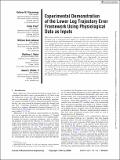Experimental Demonstration of the Lower Leg Trajectory Error Framework Using Physiological Data as Inputs
Author(s)
Olesnavage, Kathryn M; Prost, Victor; Johnson, William Brett; Major, Matthew J; Winter, Amos G
DownloadPublished version (1.867Mb)
Publisher Policy
Publisher Policy
Article is made available in accordance with the publisher's policy and may be subject to US copyright law. Please refer to the publisher's site for terms of use.
Terms of use
Metadata
Show full item recordAbstract
© 2021 by ASME. While many studies have attempted to characterize the mechanical behavior of passive prosthetic feet to understand their influence on amputee gait, the relationship between mechanical design and biomechanical performance has not yet been fully articulated from a fundamental physics perspective. A novel framework, called lower leg trajectory error (LLTE) framework, presents a means of quantitatively optimizing the constitutive model of prosthetic feet to match a reference kinematic and kinetic dataset. This framework can be used to predict the required stiffness and geometry of a prosthesis to yield a desired biomechanical response. A passive prototype foot with adjustable ankle stiffness was tested by a unilateral transtibial amputee to evaluate this framework. The foot condition with LLTE-optimal ankle stiffness enabled the user to replicate the physiological target dataset within 16% root-mean-square (RMS) error. Specifically, the measured kinematic variables matched the target kinematics within 4% RMS error. Testing a range of ankle stiffness conditions from 1.5 to 24.4 N·m/deg with the same user indicated that conditions with lower LLTE values deviated the least from the target kinematic data. Across all conditions, the framework predicted the horizontal/vertical position, and angular orientation of the lower leg during midstance within 1.0 cm, 0.3 cm, and 1.5 deg, respectively. This initial testing suggests that prosthetic feet designed with low LLTE values could offer benefits to users. The LLTE framework is agnostic to specific foot designs and kinematic/kinetic user targets, and could be used to design and customize prosthetic feet.
Date issued
2021Department
Massachusetts Institute of Technology. Department of Mechanical EngineeringJournal
Journal of Biomechanical Engineering
Publisher
ASME International
Citation
Olesnavage, Kathryn M, Prost, Victor, Johnson, William Brett, Major, Matthew J and Winter, Amos G. 2021. "Experimental Demonstration of the Lower Leg Trajectory Error Framework Using Physiological Data as Inputs." Journal of Biomechanical Engineering, 143 (3).
Version: Final published version